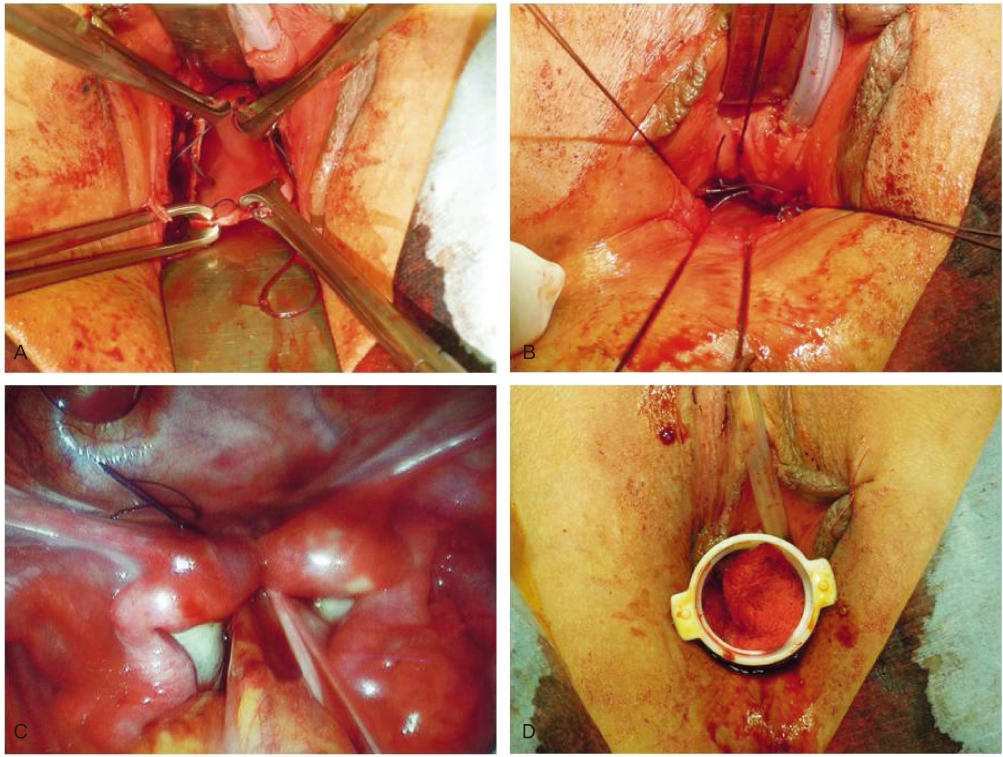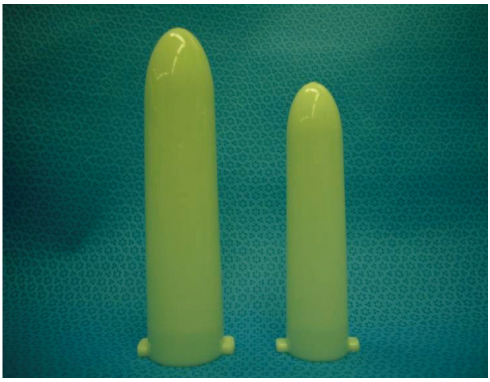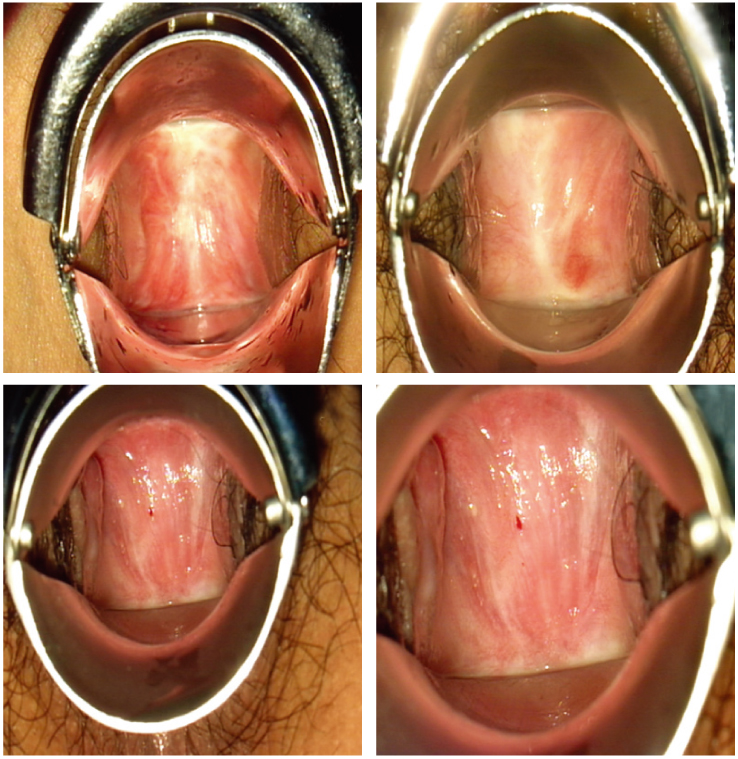Korean J Obstet Gynecol.
2012 Mar;55(3):148-157. 10.5468/KJOG.2012.55.3.148.
Results of laparoscopic davydov technique in 47 patients with congenital absence of the vagina: laparoscopic peritoneal vaginoplasty
- Affiliations
-
- 1Department of Obstetrics and Gynecology, Yonsei University College of Medicine, Seoul, Korea. dr222@yuhs.ac
- 2Department of Obstetrics and Gynecology, SAM Ahnayang Hospital, Ahnayang, Korea.
- KMID: 2274119
- DOI: http://doi.org/10.5468/KJOG.2012.55.3.148
Abstract
OBJECTIVE
To evaluate the technical feasibility and anatomical and functional outcomes of laparoscopic Davydov technique (transvestibular vaginoplasty with pelvic peritoneum) for the patients with Mayer-Rokitansky-Kuster-Hauser (MRKH) syndrome.
METHODS
This study was a retrospective review of prospectively collected data of 47 women with MRKH syndrome between 2005 and 2011. Clinical examination, pelvic ultrasound, intravenous urography and/or renal ultrasound, laparoscopy, karyotyping, orthopedics and ears, nose, and throat examination, magnetic resonance imaging was performed and 47 patients with MRKH syndrome underwent surgery with the procedure. Their clinical, surgical, and follow-up data were recorded and the functional outcome was assessed by a brief and valid self-report questionnaire evaluating female sexual life (Female Sexual Function Index, FSFI). A control group was recruited to compare the results.
RESULTS
The mean operative time was 117.2 +/- 35.3 minutes. Two intra-operative rectal and one bladder injury were repaired without sequels. One patients had vault granulation at the neovagina, which healed after electric cautery and one patient had mild enterocele. The mean length of the neovagina was 8.3 +/- 1.1 cm (range, 6 to 11 cm) without any shrinkage at the follow-up of 18.9 months (range, 6 to 53 months) after operation. The neovaginal introitus admitted two fingers in width in all patients. There was no statistical difference in the total FSFI between the case and control groups.
CONCLUSION
Laparoscopic Davydov is a safe, effective treatment of MRKH syndrome with minimal invasion and a relatively low complication rate. The procedure has satisfactory anatomical and functional results. This technique offers advantages such as: short operating time and hospital stay, no particular instrumentation required and no external scars. Sexuality approaches so-called 'normal sexuality.'
Keyword
MeSH Terms
-
Abnormalities, Multiple
Cautery
Cicatrix
Ear
Female
Fingers
Follow-Up Studies
Gynecological Examination
Hernia
Humans
Karyotyping
Kidney
Laparoscopy
Length of Stay
Magnetic Resonance Imaging
Mullerian Ducts
Nose
Operative Time
Orthopedics
Pharynx
Prospective Studies
Surveys and Questionnaire
Retrospective Studies
Sexuality
Somites
Spine
Urinary Bladder
Urography
Uterus
Vagina
Abnormalities, Multiple
Kidney
Mullerian Ducts
Somites
Spine
Uterus
Vagina
Figure
Reference
-
1. Rokitansky K. Über die sogenannte verdopplung des uterus. Med Jahrb Österr Staat. 1838. 26:39–42.2. ACOG Committee on Adolescent Health Care. ACOG Committee Opinion No. 355: Vaginal agenesis: diagnosis, management, and routine care. Obstet Gynecol. 2006. 108:1605–1609.3. Oppelt P, Renner SP, Kellermann A, Brucker S, Hauser GA, Ludwig KS, et al. Clinical aspects of Mayer-Rokitansky-Kuester-Hauser syndrome: recommendations for clinical diagnosis and staging. Hum Reprod. 2006. 21:792–797.4. Basile C, De Michele V. Renal abnormalities in Mayer-Rokitanski-Kuster-Hauser syndrome. J Nephrol. 2001. 14:316–318.5. Ganie MA, Laway BA, Ahmed S, Alai MS, Lone GN. Mayer-Rokintansky-Kuster-Hauser syndrome associated with atrial septal defect, partial anomalous pulmonary venous connection and unilateral kidney: an unusual triad of anomalies. J Pediatr Endocrinol Metab. 2010. 23:1087–1091.6. Sultan C, Biason-Lauber A, Philibert P. Mayer-Rokitansky-Kuster-Hauser syndrome: recent clinical and genetic findings. Gynecol Endocrinol. 2009. 25:8–11.7. Guerrier D, Mouchel T, Pasquier L, Pellerin I. The Mayer-Rokitansky-Kuster-Hauser syndrome (congenital absence of uterus and vagina): phenotypic manifestations and genetic approaches. J Negat Results Biomed. 2006. 5:1.8. Langer M, Grünberger W, Ringler M. Vaginal agenesis and congenital adrenal hyperplasia. Psychosocial sequelae of diagnosis and neovagina formation. Acta Obstet Gynecol Scand. 1990. 69:343–349.9. Golan A, Langer R, Bukovsky I, Caspi E. Congenital anomalies of the mullerian system. Fertil Steril. 1989. 51:747–755.10. Rock JA, Breech LL. Rock JA, Jones HW, editors. Surgery for anomalies of the müllerian ducts. Te Linde's operative gynecology. 2003. 9th ed. Philadelphia (PA): Lippincott William & Wilkins;705–752.11. Frank RT. The formation of an artificial vagina without operation. Am J Obstet Gynecol. 1938. 35:1053–1055.12. Ingram JM. The bicycle seat stool in the treatment of vaginal agenesis and stenosis: a preliminary report. Am J Obstet Gynecol. 1981. 140:867–873.13. McIndoe AH, Banister JB. An operation for the cure of congenital absence of the vagina. J Obstet Gynecol Br Common. 1938. 45:490–494.14. Noguchi S, Nakatsuka M, Sugiyama Y, Chekir C, Kamada Y, Hiramatsu Y. Use of artificial dermis and recombinant basic fibroblast growth factor for creating a neovagina in a patient with Mayer-Rokitansky-Kuster-Hauser syndrome. Hum Reprod. 2004. 19:1629–1632.15. Sheares BH. Congenital atresia of the vagina: a new technique for tunnelling the space between bladder and rectum and construction of the new vagina by a modified Wharton technique. J Obstet Gynaecol Br Emp. 1960. 67:24–31.16. Selvaggi G, Monstrey S, Depypere H, Blondeel P, Van Landuyt K, Hamdi M, et al. Creation of a neovagina with use of a pudendal thigh fasciocutaneous flap and restoration of uterovaginal continuity. Fertil Steril. 2003. 80:607–611.17. Lin WC, Chang CY, Shen YY, Tsai HD. Use of autologous buccal mucosa for vaginoplasty: a study of eight cases. Hum Reprod. 2003. 18:604–607.18. Fotopoulou C, Sehouli J, Gehrmann N, Schoenborn I, Lichtenegger W. Functional and anatomic results of amnion vaginoplasty in young women with Mayer-Rokitansky-Küster-Hauser syndrome. Fertil Steril. 2010. 94:317–323.19. Zhou JH, Sun J, Yang CB, Xie ZW, Shao WQ, Jin HM. Long-term outcomes of transvestibular vaginoplasty with pelvic peritoneum in 182 patients with Rokitansky's syndrome. Fertil Steril. 2010. 94:2281–2285.20. Davydov SN. Colpopoiesis from the peritoneum of the uterorectal space. Obstet Gynecol. 1968. 100:512–520.21. Rothman D. The use of peritoneum in the construction of a vagina. Obstet Gynecol. 1972. 40:835–838.22. Tamaya T, Imai A. The use of peritoneum for vaginoplasty in 24 patients with congenital absence of the vagina. Arch Gynecol Obstet. 1991. 249:15–17.23. Communal PH, Chevret-Measson M, Golfier F, Raudrant D. Sexuality after sigmoid colpopoiesis in patients with Mayer-Rokitansky-Kuster-Hauser Syndrome. Fertil Steril. 2003. 80:600–606.24. Darai E, Toullalan O, Besse O, Potiron L, Delga P. Anatomic and functional results of laparoscopic-perineal neovagina construction by sigmoid colpoplasty in women with Rokitansky's syndrome. Hum Reprod. 2003. 18:2454–2459.25. Karateke A, Haliloglu B, Parlak O, Cam C, Coksuer H. Intestinal vaginoplasty: seven years' experience of a tertiary center. Fertil Steril. 2010. 94:2312–2315.26. Borkowski A, Czaplicki M, Dobronski P. Twenty years of experience with Krzeski's cystovaginoplasty for vaginal agenesis in Mayer-Rokitansky-Kuster-Hauser syndrome: anatomical, histological, cytological and functional results. BJU Int. 2008. 101:1433–1440.27. Vecchietti G. Creation of an artificial vagina in Rokitansky-Kuster-Hauser syndrome. Attual Ostet Ginecol. 1965. 11:131–147.28. Folgueira G, Perez-Medina T, Martinez-Cortes L, Martinez-Lara A, Gomez B, Izquierdo J, et al. Laparoscopic creation of a neovagina in Mayer-Rokitansky-Kuster-Hauser syndrome by modified Vecchietti’s procedure. Eur J Obstet Gynecol Reprod Biol. 2006. 127:240–243.29. Walch K, Kowarik E, Leithner K, Schätz T, Dörfler D, Wenzl R. Functional and anatomic results after creation of a neovagina according to Wharton-Sheares-George in patients with Mayer-Rokitansky-Kuster-Hauser syndrome-long-term follow-up. Fertil Steril. 2011. 96:492.e1–497.e1.30. Creatsas G, Deligeoroglou E. Vaginal aplasia and reconstruction. Best Pract Res Clin Obstet Gynaecol. 2010. 24:185–191.31. Creatsas G, Deligeoroglou E, Christopoulos P. Creation of a neovagina after Creatsas modification of Williams vaginoplasty for the treatment of 200 patients with Mayer-Rokitansky-Kuster-Hauser syndrome. Fertil Steril. 2010. 94:1848–1852.32. Bianchi S, Frontino G, Ciappina N, Restelli E, Fedele L. Creation of a neovagina in Rokitansky syndrome: comparison between two laparoscopic techniques. Fertil Steril. 2011. 95:1098.e1-3–1100.e1-3.33. Fedele L, Bianchi S, Frontino G, Fontana E, Restelli E, Bruni V. The laparoscopic Vecchietti's modified technique in Rokitansky syndrome: anatomic, functional, and sexual long-term results. Am J Obstet Gynecol. 2008. 198:377.e1-6.34. Fedele L, Bianchi S, Zanconato G, Raffaelli R. Laparoscopic creation of a neovagina in patients with Rokitansky syndrome: analysis of 52 cases. Fertil Steril. 2000. 74:384–389.35. Soong YK, Chang FH, Lai YM, Lee CL, Chou HH. Results of modified laparoscopically assisted neovaginoplasty in 18 patients with congenital absence of vagina. Hum Reprod. 1996. 11:200–203.36. Williams EA. Congenital Absence of the Vagina: A Simple Operation for Its Relief. J Obstet Gynaecol Br Commonw. 1964. 71:511–512.37. Giannesi A, Marchiole P, Benchaib M, Chevret-Measson M, Mathevet P, Dargent D. Sexuality after laparoscopic Davydov in patients affected by congenital complete vaginal agenesis associated with uterine agenesis or hypoplasia. Hum Reprod. 2005. 20:2954–2957.38. Thomas JC, Brock JW 3rd. Vaginal substitution: attempts to create the ideal replacement. J Urol. 2007. 178:1855–1859.39. Routh JC, Laufer MR, Cannon GM Jr, Diamond DA, Gargollo PC. Management strategies for Mayer-Rokitansky-Kuster-Hauser related vaginal agenesis: a cost-effectiveness analysis. J Urol. 2010. 184:2116–2121.40. Belleannée G, Brun JL, Trouette H, Mompart JP, Goussot JF, Brun G, et al. Cytologic findings in a neovagina created with Vecchietti's technique for treating vaginal aplasia. Acta Cytol. 1998. 42:945–948.41. Ismail IS, Cutner AS, Creighton SM. Laparoscopic vaginoplasty: alternative techniques in vaginal reconstruction. BJOG. 2006. 113:340–343.42. Adamyan LV. Nichols DH, editor. Additional international perspectives. Gynecologic and obstetric surgery. 1993. New York (NY): Mosby;1167–1182.43. Hensle TW, Chang DT. Vaginal reconstruction. Urol Clin North Am. 1999. 26:39–47.44. ACOG Committee on Adolescent Health Care. ACOG Committee Opinion. Number 274, July 2002. Nonsurgical diagnosis and management of vaginal agenesis. Obstet Gynecol. 2002. 100:213–216.45. Ismail-Pratt IS, Bikoo M, Liao LM, Conway GS, Creighton SM. Normalization of the vagina by dilator treatment alone in Complete Androgen Insensitivity Syndrome and Mayer-Rokitansky-Kuster-Hauser Syndrome. Hum Reprod. 2007. 22:2020–2024.46. Bach F, Glanville JM, Balen AH. An observational study of women with müllerian agenesis and their need for vaginal dilator therapy. Fertil Steril. 2011. 96:483–486.47. Liao L, Doyle J, Crouch NS, Creighton SM. Dilation as treatment for vaginal agenesis and hypoplasia: a pilot exploration of benefits and barriers as perceived by patients. J Obstet Gynaecol. 2006. 26:144–148.48. Højsgaard A, Villadsen I. McIndoe procedure for congenital vaginal agenesis: complications and results. Br J Plast Surg. 1995. 48:97–102.49. Buss JG, Lee RA. McIndoe procedure for vaginal agenesis: results and complications. Mayo Clin Proc. 1989. 64:758–761.50. Strickland JL, Cameron WJ, Kranz KE. Long-term satisfaction of adults undergoing McIndoe vaginoplasty as adolescents. Adolesc Pediatr Gynecol. 1993. 6:135–137.51. Andryjowicz E, Qizilbash AH, DePetrillo AD, O'Connell GJ, Taylor MH. Adenocarcinoma in a cecal neovagina--complication of irradiation: report of a case and review of literature. Gynecol Oncol. 1985. 21:235–239.52. Baltzer J, Zander J. Primary squamous cell carcinoma of the neovagina. Gynecol Oncol. 1989. 35:99–103.53. Hendren WH, Atala A. Use of bowel for vaginal reconstruction. J Urol. 1994. 152:752–755.54. Parsons JK, Gearhart SL, Gearhart JP. Vaginal reconstruction utilizing sigmoid colon: Complications and long-term results. J Pediatr Surg. 2002. 37:629–633.55. Burgu B, Duffy PG, Cuckow P, Ransley P, Wilcox DT. Long-term outcome of vaginal reconstruction: comparing techniques and timing. J Pediatr Urol. 2007. 3:316–320.56. Borruto F, Chasen ST, Chervenak FA, Fedele L. The Vecchietti procedure for surgical treatment of vaginal agenesis: comparison of laparoscopy and laparotomy. Int J Gynaecol Obstet. 1999. 64:153–158.57. Langebrekke A, Istre O, Busund B, Sponland G, Gjønnaess H. Laparoscopic assisted colpoiesis according to Davydov. Acta Obstet Gynecol Scand. 1998. 77:1027–1028.58. Fedele L, Busacca M, Candiani M, Vignali M. Laparoscopic creation of a neovagina in Mayer-Rokitansky-Kuster-Hauser syndrome by modification of Vecchietti's operation. Am J Obstet Gynecol. 1994. 171:268–269.59. Vecchietti G. Construction of a functional vagina: a new approach to the Rokitansky-Kuster-Hauser syndrome. Clin Exp Obstet Gynecol. 1974. 2:3–8.60. Gauwerky JF, Wallwiener D, Bastert G. An endoscopically assisted technique for construction of a neovagina. Arch Gynecol Obstet. 1992. 252:59–63.61. Popp LW, Ghirardini G. Creation of a neovagina by pelviscopy. J Laparoendosc Surg. 1992. 2:165–173.62. Liu X, Liu M, Hua K, Li B, Guo SW. Sexuality after laparoscopic peritoneal vaginoplasty in women with Mayer-Rokitansky-Kuster-Hauser syndrome. J Minim Invasive Gynecol. 2009. 16:720–729.63. Tamaya T, Fujimoto J. Comparison between transabdominal-vulvar and transvulvar approaches for peritoneal vaginoplasty in patients with congenital absence of the vagina. Eur J Obstet Gynecol Reprod Biol. 1997. 72:79–81.64. Herman CJ, Willemsen WN, Mastboom JL, Vooijs GP. Artificial vaginas: possible sources of epithelialization. Hum Pathol. 1982. 13:1100–1105.
- Full Text Links
- Actions
-
Cited
- CITED
-
- Close
- Share
- Similar articles
-
- Novel vaginoplasty technique involving the use of peritoneal flaps during laparoscopic radical hysterectomy for early-stage cervical cancer
- Impact of peritoneal vaginoplasty combined with radical hysterectomy on the quality of sexual life for patients with early-stage cervical cancer: trial protocol for a multi-center superiority randomized controlled trial
- Six cases of laparoscopic assisted neovaginoplasty using pelvic peritoneal flap in MRKH syndrome
- A New Method for Laparoscopic Port Insertion Using Exposure of the Rectus Sheath Fascia and Z-type Sutures
- Laparoscopic Primary Endorectal Pull-through Procedure (Boley's) for Hirschsprung's Disease




